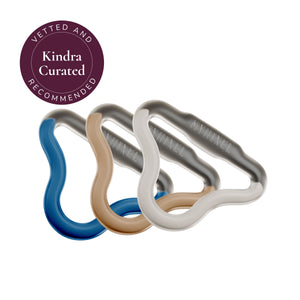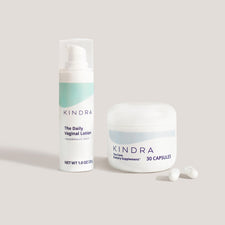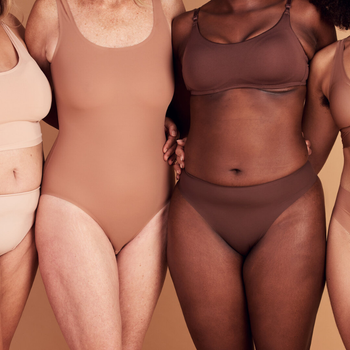7 Vaginal Changes During Menopause & How to Support Your Comfort
Menopause brings a host of changes—some expected, others less known—especially in vulvovaginal health. Understanding these normal shifts is the first step to staying comfortable, confident, and intimate.
1. Thinning & Loss of Elasticity
With menopause, declining estrogen disrupts healthy cell turnover, leading to a thin vaginal epithelium with fewer superficial cells and reduced collagen/elastin structure. Histologically, this manifests as diminished epithelial layers, increased parabasal cells, and reduced connective tissue integrity.
Clinical impact: Vaginal tissues are more susceptible to microtrauma, petechiae, and inflammation during natural movement or sexual activity .
2. Vaginal Dryness & Discomfort (Genitourinary Syndrome of Menopause, GSM)
Low estrogen also means fewer mucus-secreting cells and less vascular support, leading to dryness, burning, and dyspareunia. Surveys show about 50% of postmenopausal women experience GSM symptoms like dryness, itchiness, dysuria, and painful sex. Reduce dryness, irritation, and painful sex when you add a vulvovaginal moisturizer to your routine like the Daily V Lotion or V Relief Serum.
Vaginal Moisturizers
3. Labial Atrophy (“Disappearing Labia”)
Estrogen receptors in labial skin and vulva tissues decrease activity post-menopause, resulting in contraction, thinning, and loss of fullness in the labia minora/majora. This makes vulvar skin fragile, more susceptible to fissures, irritation, and psychological discomfort from appearance changes .
4. Increased Risk of UTIs & pH Shifts
Estrogen supports Lactobacilli growth, which maintains low vaginal pH (<4.5). The postmenopausal vagina typically shifts to a less acidic pH (becoming more alkaline), creating conditions where protective Lactobacillus species struggle to thrive. This increases the risk of bacterial vaginosis and UTIs.
In a clinical study of Pycnogenol, MenoRelief's core ingredient, researchers found that it was more effect at reducing UTIs than cranberry extract and after 60 days 100% of participants were infection-free.
MenoRelief
5. Reduced Vaginal Lubrication
Estrogen enhances blood flow, glandular secretion, and tissue rugae formation. With less estrogen, lubrication drops and tissues lose elasticity. This leads to friction during intimacy, increasing pain and dyspareunia—as many as 76% of postmenopausal women are affected. Kindra's V Lube Silicone-Based Lubricant feels like natural lubrication and helps reduce pain with intimacy. V Lube is a FDA-cleared silicone-based formula that is non-irritating, long-lasting and waterproof.
V Lube
6. Pelvic Floor Weakness
Estrogen is key for pelvic muscle tone, vascular supply, and tissue elasticity. A hypoestrogenic state weakens pelvic floor muscles and supporting structures. This can contribute to urinary incontinence, pelvic organ prolapse, and reduce vaginal sensation .
7. Itching, Burning & Discomfort
The thin, fragile vaginal epithelium frequently becomes prone to superficial bleeding, inflammation, fissures, and contact dermatitis from products or bedding fabrics. Kinda's V Relief Serum acts as a protective layer to soothe irritated intimate skin.
Why Moisturizers + Lubes Matter for Menopausal Vaginal Health
As estrogen levels decline during perimenopause and postmenopause, the vaginal and vulvar tissues undergo profound changes that can affect comfort, sexual intimacy, and everyday wellness. Incorporating a daily vaginal moisturizer and intimacy-safe lubricant is a clinically supported, non-hormonal way to combat the symptoms of Genitourinary Syndrome of Menopause (GSM)—including dryness, itching, burning, irritation, and painful sex (dyspareunia).
What Are Vaginal Moisturizers?
Vaginal moisturizers are hormone-free, topical treatments designed to replenish hydration and support tissue health over time. Unlike lubricants, which offer short-term glide during intimacy, moisturizers are absorbed into the skin and work continuously—especially when used daily.
Clinical benefits of consistent vaginal moisturizing include:
-
Improved elasticity of vulvovaginal tissue
-
Reduction in dryness, itching, and irritation
-
Enhanced natural lubrication
-
Better pH balance and microbiome support
-
Improved intimacy comfort over time
According to The North American Menopause Society (NAMS), non-hormonal vaginal moisturizers are the first-line treatment for mild to moderate vaginal dryness in postmenopausal women who do not use estrogen therapy.
What About Lubricants?
Lubricants provide instant relief from friction and dryness during sexual activity. Silicone-based lubricants, like Kindra’s V Lube, are particularly effective for menopausal women because they’re longer-lasting and don’t evaporate quickly like water-based formulas. They’re also ideal for use with silicone-compatible toys and latex condoms.
Why choose a silicone lubricant?
-
Doesn’t dry out or become sticky
-
Requires less reapplication
-
Safe for sensitive tissue
-
Ideal for those experiencing severe vaginal dryness or thinning
Why You Need Both
Using a moisturizer daily and a lubricant during intimacy offers a holistic approach to vaginal wellness.
Leave a Reply
Tags: About Menopause Body Talk Dry Skin Health & Wellness Our Products Vagina

















